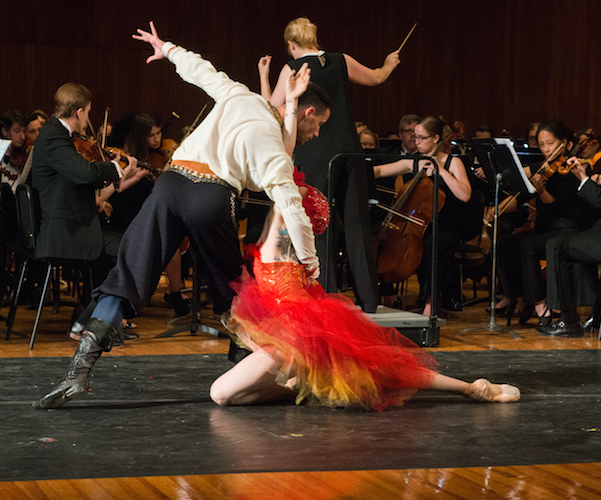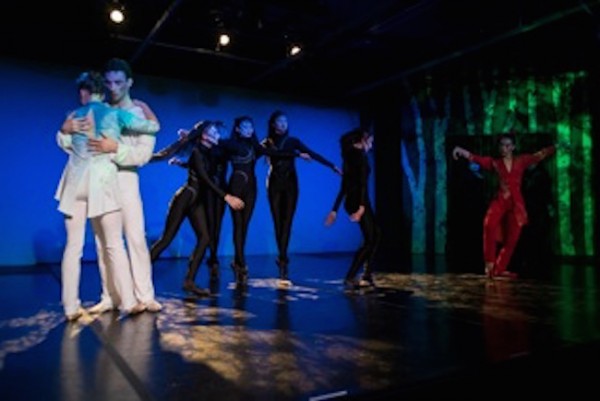Fuse Dance Review: Birds in the Hands — “The Firebird”
The coincidence of two Firebirds in one weekend suggested a Compare-and-Contrast exercise.
The Firebird, Gianni Di Marco, choreographer, with the Cambridge Symphony Orchestra at Kresge Auditorium, MIT, Cambridge MA, June 17.
Firebird, Lorraine Chapman, choreographer, with the North Atlantic Dance Theatre at Next Door Theatre, Winchester, MA, June 17-19.

Ivan and the Firebird, with conductor Cynthia Woods behind them during the Cambridge Symphony Orchestra’s presentation of “The Firebird.” Photo: Steve Wollkind.
By Marcia B. Siegel
Two Boston-based choreographers tackled a legendary 20th century ballet last week. The coincidence of two Firebirds in one weekend suggested a Compare-and-Contrast exercise, but the only thing the two makeovers had in common was a reduction in scale.
Gianni Di Marco’s “semi-staged” version was made for the Cambridge Symphony Orchestra. The single performance took place Saturday night in MIT’s Kresge Auditorium, not an ideal place for a theatrical production. The domed structure, built in the mid-1950s by architect Eero Saarinen, is like a giant sounding board, with wooden walls and acoustic panels that float overhead, and a wide, shallow seating area that made it possible for the friendly audience to see and hear all 80 members of the orchestra. The curtainless curtain-raiser was another dark European fairy tale, Antonin Dvorák’s 1896 “The Water Goblin.”
The original Firebird, choreographed in 1910 by Michel Fokine, with Igor Stravinsky’s first major score, established the Diaghilev Ballets Russes’s reputation and made stars of the creators. In brief, the plot goes: the Tsarevich Ivan finds a garden in the forest and captures the mysterious Firebird. In return for her release, she gives him a magic feather. In the same garden he discovers a troupe of maidens and falls in love with their leader, the Princess (or Tsarevna, depending on which version you’re seeing). She and her companions are prisoners of the evil Kaschei. Later, Ivan uses the magic feather to summon the Firebird; she comes to the rescue and subdues Kaschei and his monsters. Ivan marries the princess and the monarchy lives on.
Di Marco’s challenge was having to confine the dance to a narrow space in front of the musicians — there is no orchestra pit in Kresge. Wisely, he confined the cast to seven dancers and shrank the original libretto accordingly. The dancing was modest, the action held back.
One good idea was to use Stravinsky’s overture, with its lurking deep tones, for a preview of how the magician Kaschei (played by the choreographer) captured the Princess (Jaime Derocker). They’re seen in a stage box high above the stage. When Prince Ivan (played here by Alan Alberto) climbs over an imaginary wall he sees a mysterious Firebird (Ruth Whitney).
Instead of leaping about the garden, Di Marco’s Firebird spun and flapped her arms—I thought the narrow strip of dancing space would have made jetés dangerous. The capture duet contained some interesting lifts and lots of turning. The Princess and her two companions (Brenna Difrancesco and Tegan Rich) rushed about with small skipping jumps. Hardly had Ivan and the Princess established themselves as a couple when four monsters appeared (the two assistant princesses plus Jacob Hoover and Harunaga Yamakawa, dressed in monster costumes). They pretended to struggle. By this time even the dancing looked fake.
But the evening was meant to belong to the orchestra. Even the program gave a synopsis for the original ballet, which described the music’s libretto, not the stage action. Di Marco deferred to the orchestra for long interludes during which, in standard versions of the ballet, there’s usually something going on on the stage. With the orchestra in front of me instead of in the pit, as it is for standard versions of Firebird, I heard the music differently. I especially could appreciate the way conductor Cynthia Woods and Saarinen’s building allowed the audience to hear Stravinsky’s wonderful passages featuring woodwinds, brasses, and percussion.
I didn’t expect Lorraine Chapman’s Firebird to look like Fokine’s either. Her version for North Atlantic Dance Theatre was dependably goofy, and even less tied to the original libretto than Di Marco’s. It also looked much more confident of its own limited aspirations. Chapman offered the same four principals: the Firebird, Li-Ann Lim; Prince Ivan, Vincent Brewer; Princess Tsarevna, Katrina Gould; and an eccentrically spelled Kostechei, NADT director Lucy Warren-Whitman. The six-person corps of Bolibotshki Monsters were students of local dance schools. Daniel Chapman and Edward Chapman supplied a few cryptic hints about the plot on an upstage screen, and a forest of projected birch trees to make the pocket theater’s existing box set look less like a drawing-room. The music was recorded. Warren-Whitman and Lim designed the costumes, which I thought were exceptionally good-looking. Though simple, they suited their wearers well and moved beautifully with the dancers’ movement.
I thought the whole performance was interesting although after it was all over I didn’t really know what had happened. There seemed to be a lot of symbolism around the idea of eggs. Kostechei’s soul is supposed to be contained in an egg, which Ivan breaks in the original ballet, thus destroying the evil magician and his power. If I understood the projected program introduction, the egg had been broken before the dance began.
Brewer’s Prince Ivan arrives with an outsize pair of binoculars; he’s supposed to be a bird watcher. He acted the bumpkin throughout, losing the Firebird’s magic feather during one of his passionate scenes with the Princess. The two of them had a long, awkward love scene on a bench after the monsters had been dispatched.

The Prince and Princess show dancing during the North Atlantic Dance Theatre production of “Firebird.” Photo: courtesy of the North Atlantic Dance Theatre.
I didn’t know how to read the strange characters and how they related to each other. At times it seemed the Firebird was a rival for Ivan’s affections: once or twice she danced a pas de trois with him and the Princess. Clueless Ivan couldn’t make up his mind between them. Sometimes the Firebird and the Princess mirrored each other like rivals; at other times they seemed to be allies, or even in love. I wondered if Kostechei was trying to capture the Firebird or whether I was looking at a seduction.
The Princess and the Firebird were both on pointe, as were the monsters. To show what was happening to the characters, Chapman added some eccentric gestures and offbeat ways of doing the classical steps. Gould, who had danced with technical assurance, had a variation where she seemed to be off-kilter, as if bewitched by Kostechei. Lim at one point tried to fly, but her arms seemed pinned by the magician’s invisible chains. Warren-Whitman gleefully stalked her victims and conducted the monsters’ dance with clawing hands. At last, the Firebird, Ivan, and the Princess got together and slowly kicked her into the wings.
There may be some other egg connection because the Firebird is first seen curled up in a nest, like an egg herself, then rises up in the nest downstage at the end of the wedding. She sits perfectly still, on a very large egg, during Stravinsky’s majestic final chords, and a projection behind her registers a huge question mark.
Internationally known writer, lecturer, and teacher Marcia B. Siegel covered dance for 16 years at The Boston Phoenix. She is a contributing editor for The Hudson Review. The fourth collection of Siegel’s reviews and essays, Mirrors and Scrims—The Life and Afterlife of Ballet, won the 2010 Selma Jeanne Cohen prize from the American Society for Aesthetics. Her other books include studies of Twyla Tharp, Doris Humphrey, and American choreography. From 1983 to 1996, Siegel was a member of the resident faculty of the Department of Performance Studies, Tisch School of the Arts, New York University.
Tagged: Cambridge Symphony Orchestra, Dance, Firebird, Gianni Di Marco, Lorraine Chapman, Marcia B. Siegel, Next Door Theatre
